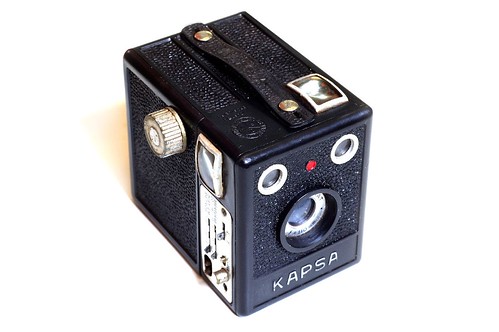Use Your Holga with 135
We all know that normal Holgas take 120 film, which you either have to develop yourself (and mess it up if your me) or send it off to an expensive lab. But it is actually very easy to temporarily convert it to take 135 film without buying the back! So let's get started.
You will need:

Step One: Open the back of your holga. You will need either the 6x6 or 6x4.5 mask if you want to get the images printed normally.

Step Two: Get the spool and wrap the rubber bands around either end to leave a gap that is big enough the let the film through.


Step Three: Attach the film leader to the spool with tape.

Step Four: To make the 135 mask, get some black card stock (this is 160g) and cut out a square that's about 63mm square, then in the middle cut out a gap that is exactly 36mm wide and either 24mm or 36mm high (depending whether you want the sprockettes exposed).

Step Five: Place the spool in the right hand side, like loading the 120 film.

Step Six: Place the canister in the left had side and support the top and bottom with the foam. Layers of thick card might work, too.

Step Seven: Because 135 has no backing, you will need to block off the window with the electrical tape. I have only done one layer hear, but feel free to do more.

Also block it off on the inside for maximum light-proofing.

Step Eight: Close it all up and wind the film on a turn and a half and your all set. For even more security, you may wish to seal all round the edges with tape.

When you have taken a shot, wind the film on 21 clicks, if you want to try with wider shots, calculate yourself how many clicks you'll need. It helps to use a piece of paper or something.
What do the results look like? Take a look for your self.



You will need:
- Your Holga120 (mines the GCFN)
- A used 120 spool (I don't know why I put two in the photo)
- Electrical tape (gaffer tape will also work, but it leaves sticky gunk)
- Bits of foam
- Rubber bands (the thick ones work well)
- A roll of film (I know this one is already developed, it was completely over-exposed so I put it in a canister for tests like this)

Step One: Open the back of your holga. You will need either the 6x6 or 6x4.5 mask if you want to get the images printed normally.

Step Two: Get the spool and wrap the rubber bands around either end to leave a gap that is big enough the let the film through.


Step Three: Attach the film leader to the spool with tape.

Step Four: To make the 135 mask, get some black card stock (this is 160g) and cut out a square that's about 63mm square, then in the middle cut out a gap that is exactly 36mm wide and either 24mm or 36mm high (depending whether you want the sprockettes exposed).

Step Five: Place the spool in the right hand side, like loading the 120 film.

Step Six: Place the canister in the left had side and support the top and bottom with the foam. Layers of thick card might work, too.

Step Seven: Because 135 has no backing, you will need to block off the window with the electrical tape. I have only done one layer hear, but feel free to do more.

Also block it off on the inside for maximum light-proofing.

Step Eight: Close it all up and wind the film on a turn and a half and your all set. For even more security, you may wish to seal all round the edges with tape.

When you have taken a shot, wind the film on 21 clicks, if you want to try with wider shots, calculate yourself how many clicks you'll need. It helps to use a piece of paper or something.
What do the results look like? Take a look for your self.



Labels: 120, 135, 35, 35mm, camera, convert, holga, kit, mm, vintage



